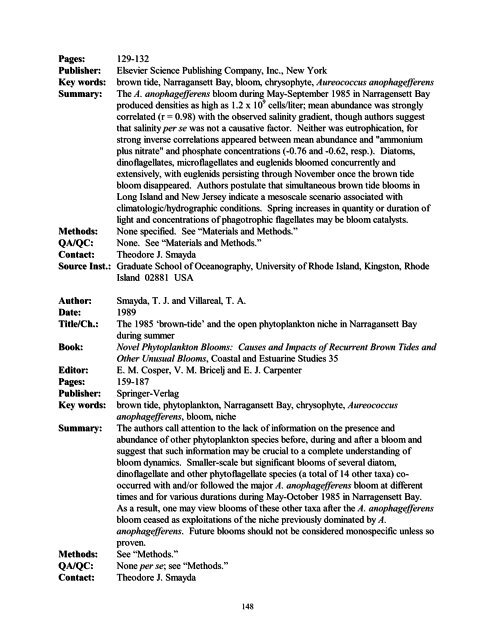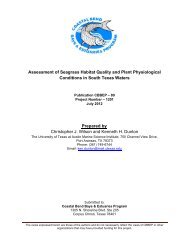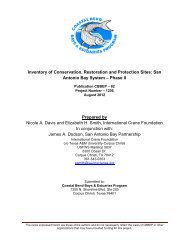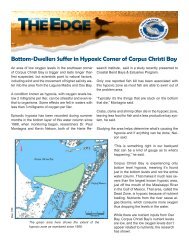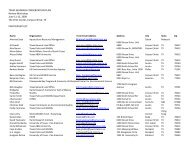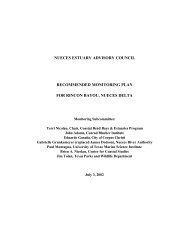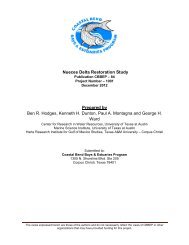Pages: 129-132Publisher: Elsevier Science Publishing Company, Inc., New YorkKey words: brown tide, Narragansett Bay, bloom, chrysophyte, Aureococcus anophagefferensSummary: The A. anophagefferens bloom during May-September 1985 in Narragensett Bayproduced densities as high as 1.2 x 10 9 cells/liter; mean abundance was stronglycorrelated (r = 0.98) with the observed salinity gradient, though authors suggestthat salinity per se was not a causative factor. Neither was eutrophication, forstrong inverse correlations appeared between mean abundance <strong>and</strong> "ammoniumplus nitrate" <strong>and</strong> phosphate concentrations (-0.76 <strong>and</strong> -0.62, resp.). Diatoms,din<strong>of</strong>lagellates, micr<strong>of</strong>lagellates <strong>and</strong> euglenids bloomed concurrently <strong>and</strong>extensively, with euglenids persisting through November once the brown tidebloom disappeared. Authors postulate that simultaneous brown tide blooms inLong Isl<strong>and</strong> <strong>and</strong> New Jersey indicate a mesoscale scenario associated withclimatologic/hydrographic conditions. Spring increases in quantity or duration <strong>of</strong>light <strong>and</strong> concentrations <strong>of</strong> phagotrophic flagellates may be bloom catalysts.Methods: None specified. See “Materials <strong>and</strong> Methods.”QA/QC: None. See “Materials <strong>and</strong> Methods.”Contact: Theodore J. SmaydaSource Inst.: Graduate School <strong>of</strong> Oceanography, University <strong>of</strong> Rhode Isl<strong>and</strong>, Kingston, RhodeIsl<strong>and</strong> 02881 USAAuthor: Smayda, T. J. <strong>and</strong> Villareal, T. A.Date: 1989Title/Ch.: The 1985 ‘brown-tide’ <strong>and</strong> the open phytoplankton niche in Narragansett Bayduring summerBook: Novel Phytoplankton Blooms: Causes <strong>and</strong> Impacts <strong>of</strong> Recurrent <strong>Brown</strong> <strong>Tide</strong>s <strong>and</strong>Other Unusual Blooms, Coastal <strong>and</strong> Estuarine Studies 35Editor: E. M. Cosper, V. M. Bricelj <strong>and</strong> E. J. CarpenterPages: 159-187Publisher: Springer-VerlagKey words: brown tide, phytoplankton, Narragansett Bay, chrysophyte, Aureococcusanophagefferens, bloom, nicheSummary: The authors call attention to the lack <strong>of</strong> information on the presence <strong>and</strong>abundance <strong>of</strong> other phytoplankton species before, during <strong>and</strong> after a bloom <strong>and</strong>suggest that such information may be crucial to a complete underst<strong>and</strong>ing <strong>of</strong>bloom dynamics. Smaller-scale but significant blooms <strong>of</strong> several diatom,din<strong>of</strong>lagellate <strong>and</strong> other phyt<strong>of</strong>lagellate species (a total <strong>of</strong> 14 other taxa) cooccurredwith <strong>and</strong>/or followed the major A. anophagefferens bloom at differenttimes <strong>and</strong> for various durations during May-October 1985 in Narragensett Bay.As a result, one may view blooms <strong>of</strong> these other taxa after the A. anophagefferensbloom ceased as exploitations <strong>of</strong> the niche previously dominated by A.anophagefferens. Future blooms should not be considered monospecific unless soproven.Methods: See “Methods.”QA/QC: None per se; see “Methods.”Contact: Theodore J. Smayda148
Source Inst.: Graduate School <strong>of</strong> Oceanography, University <strong>of</strong> Rhode Isl<strong>and</strong>, Kingston, RhodeIsl<strong>and</strong> 02881 USAAuthor: Snider, R. (ed.)Date: 1987Title: <strong>Red</strong> tide in Texas: an explanation <strong>of</strong> the phenomenonPages: 4 pp.Publisher: Marine Information Service, Texas A&M Sea Grant College ProgramKey words: red tide, din<strong>of</strong>lagellate, bloom, toxin, Ptychodiscus brevis, Gonyaulax monilata,Gulf <strong>of</strong> Mexico, fish kills, neurotoxic shellfish poisoningSummary: This pamphlet summarizes the pertinent facts about the red tide organisms,Ptychodiscus brevis <strong>and</strong> Gonyaulax monilata [now known as Gymnodinium breve<strong>and</strong> Alex<strong>and</strong>rium monilata, resp.]; causes <strong>of</strong> sudden blooms; locations <strong>and</strong> times<strong>of</strong> bloom occurrence; red tide impacts on marine life, public health <strong>and</strong> theeconomy; myths about red tides; history <strong>and</strong> folklore; <strong>and</strong> control, prevention <strong>and</strong>prediction.Methods: N/A (Public information bulletin)QA/QC: N/AContact: Rhonda SniderSource Inst.: Marine Information Service, Sea Grant College Program, Texas A&MUniversity, College Station, TX 77843-4115Author: Starr, T. J.Date: 1958Title: Notes on a toxin from Gymnodinium breveJournal: Texas Reports in Biology <strong>and</strong> Medicine 16:500-507Key words: toxin, Gymnodinium breve, bloom, algae, culture, mullet, Lebistes reticulatus,Mugel cephalus, exotoxin, endotoxinSummary: This paper describes bioassay procedures for toxin from unialgal cultures <strong>of</strong>Gymnodinium breve as well as some properties <strong>of</strong> the crude toxin. Mullet <strong>and</strong>guppies were used for the toxin bioassay; toxicity increases with any agent thatdestroys G. breve. The organism's fragile nature frustrated attempts toconcentrate the toxin by concentrating intact cells. The author cannot concludethat G. breve toxin is either a true exotoxin (produced or excreted from livingcells) or endotoxin (introduced by cell lysis or autolysis).Methods: See "Materials <strong>and</strong> Methods."QA/QC: None per se; see "Materials <strong>and</strong> Methods."Contact: Theodore J. StarrSource Inst.: The University <strong>of</strong> Texas Medical Branch, Department <strong>of</strong> Preventive Medicine <strong>and</strong>Public Health, Virus Research Laboratory, Galveston, Texas, USAAuthor: Stehn, T.Date: 1987Title: Whooping cranes during the 1986-1987 winterPages: 45 pp.Source: Aransas National Wildlife Refuge, U. S. Fish <strong>and</strong> Wildlife Service149
- Page 1 and 2:
Current Status and Historical Trend
- Page 3 and 4:
Current Status and Historical Trend
- Page 5 and 6:
Barry R. McBee, ChairmanR. B. Ralph
- Page 7:
STUDY AREA DESCRIPTIONThe CCBNEP st
- Page 10 and 11:
TABLE OF CONTENTSPagePREFACE.......
- Page 12 and 13:
LIST OF TABLESBROWN TIDETablePage1.
- Page 14 and 15:
LIST OF FIGURESFigurePage38. Growth
- Page 16:
indicating that brown tide was a po
- Page 19 and 20:
Organism:AureococcusanophageffernsT
- Page 21:
Perhaps the most important impact o
- Page 25 and 26:
Temperature and Salinity for Laguna
- Page 27 and 28:
second residence time was calculate
- Page 30 and 31:
In spite of the warm temperatures a
- Page 32 and 33:
NO 2 concentrations for Laguna Madr
- Page 34 and 35:
SiO 4 concentrations for Laguna Mad
- Page 36 and 37:
Brown Tide Counts Upper Laguna Madr
- Page 39 and 40:
D. Environmental impact1. Seagrasse
- Page 41 and 42:
Station A300Areal Shoot Biomass (gd
- Page 43:
Station A2018Root/Rhizome:Shoot Rat
- Page 47 and 48:
copepods reaching their maximum siz
- Page 49 and 50:
The observed changes in zooplankton
- Page 51 and 52:
Specific Growth Rate (day -1 )1.510
- Page 53 and 54:
Specific Growth Rate (Day -1 )0.70.
- Page 55 and 56:
Percent Survival1009080706050403020
- Page 57 and 58:
culture organism widely used as a f
- Page 59 and 60:
species of phytoplankton, and altho
- Page 61 and 62:
These results are particularly impo
- Page 63 and 64:
Larval AnchovyLarval Density (No./1
- Page 65 and 66:
60Macrofauna DiversityBaffin Bay an
- Page 67 and 68:
ABay AnchovyBStripped Mullet250600N
- Page 69 and 70:
invertebrate die-off in the freezes
- Page 71 and 72:
is a common component of phytoplank
- Page 73 and 74:
VII. Literature CitedAdmiraal, W.,
- Page 75 and 76:
DeYoe, H.R., Chan, A.M., Suttle, C.
- Page 77 and 78:
Milligan, A.J. (1992). An investiga
- Page 79 and 80:
freshwater inflow. Technical Report
- Page 81 and 82:
IX. Historical trends of Texas red
- Page 83 and 84:
Table 1. Selected Texas bays with p
- Page 85 and 86:
Galveston Island on 27 August 1986;
- Page 87 and 88:
quickly banned harvest and shipment
- Page 89 and 90:
The effects of Gymnodinium breve bl
- Page 91 and 92:
Along with favorable salinity level
- Page 93 and 94:
eproduction, but even division rate
- Page 95 and 96:
Though the data in Figure 2 appear
- Page 97 and 98:
extensive list of all fish species
- Page 99 and 100:
circulation patterns could work in
- Page 101 and 102:
Texas, a possibility that may only
- Page 103 and 104:
XIII. Literature CitedAbdelghani, A
- Page 105 and 106:
Hemmert, W. H. (1975). The public h
- Page 107 and 108:
Rounsefell, G. A., Nelson, W. R. (1
- Page 109 and 110:
Williams, J., Ingle, R. M. (1972).
- Page 111 and 112: Larvae were collected with five rep
- Page 113 and 114: waters may facilitate photoautotrop
- Page 115 and 116: Editor: E. M. Cosper, V. M. Bricelj
- Page 117 and 118: Source Inst.: Mote Marine Laborator
- Page 119 and 120: QA/QC: None per se; see “Methods.
- Page 121 and 122: Title/Ch.: Effects of a persistent
- Page 123 and 124: Key words: red tide, bloom, plankto
- Page 125 and 126: Key words: brown tide, bloom, chrys
- Page 127 and 128: Author: Cosper, E. M., Garry, R. T.
- Page 129 and 130: Pages: 128-131Publisher: ElsevierKe
- Page 131 and 132: Thesis: Role of environmental varia
- Page 133 and 134: Methods: See “Materials and Metho
- Page 135 and 136: Author: Gallager, S. M., Stoecker,
- Page 137 and 138: Journal: Science 113:250-251Key wor
- Page 139 and 140: QA/QC: None per se; see "Method."Co
- Page 141 and 142: Contact: John F. HowellSource Inst.
- Page 143 and 144: iota and inshore shellfish beds, ta
- Page 145 and 146: Author: Lowe, J. A., Farrow, D. R.
- Page 147 and 148: Date: 1992Thesis: An investigation
- Page 149 and 150: Author: Nixon, S. W., Granger, S. L
- Page 151 and 152: Source Inst.: Fisheries Research an
- Page 153 and 154: Date: 1957Title: Effects of unialga
- Page 155 and 156: Date: 1979Title/Ch.: The effect of
- Page 157 and 158: Book: Toxic Dinoflagellate Blooms,
- Page 159 and 160: Contact: Sandra E. ShumwaySource In
- Page 161: monilata] and Gymnodinium breve tox
- Page 165 and 166: substantiated for G. breve (though
- Page 167 and 168: Methods: None (review)QA/QC: N/ACon
- Page 169 and 170: Source Inst.: Florida Department of
- Page 171 and 172: 5000 cells/liter, so the cell count
- Page 173 and 174: Key words: red tide, bloom, algae,
- Page 175 and 176: Contact: Gregory A. TraceySource In
- Page 177 and 178: Author: Vargo, G. A. and Howard-Sha
- Page 179 and 180: Title/Chap.: Taxonomy and cysts of
- Page 181 and 182: Date: 1993Title/Ch.: The nutrient a
- Page 183 and 184: cell division, other possible repro
- Page 185 and 186: lue light in the same region as tha
- Page 187 and 188: Pat TesterNMFS Southeast Fisheries


